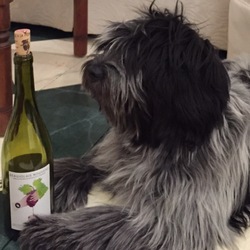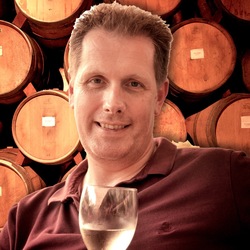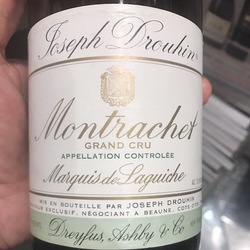Domaine Guilhem
Guilhem et Jean Hugues Goisot
L'Empreinte du Terroir Bourgogne Aligoté
Great with leftover turkey and pate — 8 years ago

Daumas Gassac
Guilhem Vin de Pays d'Hérault Rosé Blend 2018
Crushed limestone, fresh florals and just a touch of lime rind on the nose. Balanced fruit and acidity with lots of fresh/floral flavors. While nuanced at first, this one open up pleasantly. — 8 years ago
Château Guilhem
Prestige de Château Guilhem 2014
Dark, rich, complex. Tannins, some fruits, fruits, lovely — 8 years ago
Château Guilhem
Prestige de Château Guilhem Rosé Blend 2016
One of my favourite Rose's and it's from Languedoc. I think this vintage is slightly darker than previous. Tart peach, watermelon perfect BBQ wine! — 9 years ago
Domaine San Guilhem
Vin de Pays des Côtes de Gascogne Colombard 2014
It's really good — 9 years ago
Guilhem et Jean Hugues Goisot
L'Empreinte du Terroir Bourgogne Côtes d'Auxerre Chardonnay 2011
Very Chablis like. Aged and drinking well at this point. Too bad it's the last '11 I have. — 9 years ago
Guilhem et Jean Hugues Goisot
Moury Saint-Bris Sauvignon Blanc
Awesome sauv blanc from a producer in Burgundy close to the Chablis border. This vineyard site has limestone soils that you can taste in this dry mineral driven wine. Bright acidity and lean body make it a great food wine and something that will be easy to enjoy all summer long. — 10 years ago
Daumas Gassac
Guilhem Vin de Pays de l'Hérault White Blend 2014
Sophisticated and subtle. Elegant aftertaste. Complex of flavors pivots on mandarin orange, but dry. Nice with olives. — 10 years ago
Daumas Gassac
Guilhem Vin de Pays de l'Hérault Grenache Blend Rosé 2014
Nice, full, complex, but not sweet. — 10 years ago
Guilhem et Jean Hugues Goisot
Gueules de Loup L'Empreinte du Terroir Bourgogne Côtes d'Auxerre AOC Chardonnay
2012, great value Bourgogne level white Burgundy, nutty, rich and fruit driven, good natural acid, but short on the aftertaste. — 11 years ago
Château Puy Guilhem
Fronsac Red Bordeaux Blend 2003
Potential Bordeaux wine for us — 12 years ago
Guilhem et Jean Hugues Goisot
Bourgogne Côtes d'Auxerre Corps de Garde Chardonnay
Tastes of apple rind very smooth — 8 years ago
Château Brane-Cantenac
Grand Cru Classé en 1855 Margaux Red Bordeaux Blend 2005
I have a six-pack of this 05. I thought after 10 years in bottle, it would be interesting to check in on its evolution. While tasty, I’ll wait another 8-10 to open another. Even after 2-3 hours in the decanter, it’s still a very young adolescent. On the nose, slightly sour blackberries & dark cherries, dark currants, baked black plum, haunting blue fruits, anise, whiff of spice, steeped tea, dry stones, dry crushed rocks with dry top soil, caramel, vanilla with fresh & dry red florals. The body is thick & full. Tannins are starting to round out. It’s velvety on the palate. The fruits are; bright, fresh & ripe and really show the greatness of the 05 vintage. Dark currants, blackberries, dark cherries, baked black plum, haunting blue fruits, baked strawberries, cherries, raspberries on the long set, dark spice, clay & loamy dry top soil with crushed rocks, dry stones, cigar with ash, graphite, dry stems, slight herbaceous character, mint, used leather, clove, caramel, vanilla, fresh & dry red florals with violets. The round acidity is about perfect. The structure and length are still strong. The balance is in harmony. As for the long finish, it’s lush, ruby, rich and well polished. Photos of; Chateau Brane Cantenac, large wood vats, Henri Lurton and Estate vines. Producer notes and history...Chateau Brane Cantenac began in the early 17th century. At the time, the estate was known as Domaine Guilhem Hosten. Even that far back, wine was produced from the property. In fact, the wine was so highly regarded it was one of the more expensive wines in Bordeaux. It sold for almost as much money as Brane Mouton. This is interesting because of who went on to buy the vineyard in the 1800’s. The Baron of Brane, also known as “Napoleon of the Vineyards”, purchased the Chateau in 1833. At the time of the sale, the estate was called Chateau Gorce-Guy. To get the funds needed to purchase the Margaux vineyard, the Baron sold what is now called Mouton Rothschild, which was at the time of the sale, known as Chateau Brane-Mouton. Not such a good move with hundreds of years in hindsight! In 1838, the Baron renamed property taking his name and the name of the sector where the vineyards were located and called it Chateau Brane Cantenac. The Chateau later passed to the Roy family, who were well-known in the Margaux appellation in those days, as they owned Chateau d’issan. Moving ahead to 1920, the Societe des Grands Crus de France, a group of merchants and growers that owned several chateaux located in the Medoc including; Chateau Margaux, Chateau Giscours, and Chateau Lagrange in St. Julien, purchased Chateau Brane Cantenac. Five years later, M. Recapet and his son-in-law, François Lurton, took over Brane Cantenac along with Chateau Margaux. Lucien Lurton (the son of François Lurton) inherited Brane Cantenac in 1956. Today, the estate is still in the hands of the Lurton family. Brane Cantenac is owned and run by Henri Lurton. After being given the responsibility of managing Brane Cantenac, it was under the direction of Henri Lurton that large portions of the vineyard were replanted. Vine densities were increased, the drainage systems were improved and the plantings were also, slowly changed. The vineyard of Brane Cantenac is planted to 55% Cabernet Sauvignon, 40% Merlot, 4.5% Cabernet Franc and .5% Carmenere. Carmenere was used for the first time in the 2011 vintage. The only other Chateau I know that still uses Carmenere is Clerc Milon. The 75 hectare Left Bank vineyard of Brane Cantenac is essentially unchanged since it earned Second Growth status in the 1855 Classification. At least that is the case with the 45 hectares used to produce the Grand Vin of Brane Cantenac. Those 45 hectares are planted surrounding the Chateau. Those vines are located just in front of the Cantenac plateau and are the best terroir that Brane Cantenac owns. They have other parcels, which are further inland and much of those grapes are placed into their second wine, Le Baron de Brane. Those additional hectares can be divided into 3 main sections. Behind the Chateau, they have 15 hectares of vines on gravel and sand, 10 hectares across the road with sand, gravel and iron and a 13 hectare parcel with gravel called Notton, which is used for their second wine. The vineyard is planted to a vine density that ranges from 6,666 vines per hectare on the plateau and up to 8,000 vines per hectare for the vines located behind chateau, in their sandier soils. The higher levels of vine density are always found in the newer plantings. The terroir of Brane Cantenac consists of deep gravel, sand and clay soil. Experiments in the vineyards are currently looking at becoming more organic in their vineyard management. Today, more than 25% of Brane Cantenac is farmed using organic farming techniques. It is expected that over time, the amount of hectares farmed with organic methods will be increased. Brane Cantenac has gone through 2 relatively recent modernization’s in 1999, when they added began adding the first of their smaller vats to allow for parcel by parcel vinification and then again in 2015 when they completed a much more complete renovation of their cellars and vat rooms. While Brane Cantenac is a traditional producer, they are no stranger to technology as they were one of the first estates to embrace optical grape sorting machines. In very wet vintages, they can also use reverse osmosis. To produce the wine of Chateau Brane Cantenac, the wine is vinified in a combination of temperature controlled, traditional, 22 oak vats, 18 concrete tanks and 20 stainless steel vats that vary in size from 40 hectoliters all the way up to 200 hectoliters, which allows for parcel by parcel vinification. 40% of the fermentation takes place in the oak vats. The oldest vines are vinified in vats that are selected to allow for separate parcel by parcel vinification. The younger vines are vinified more often together in the same vats. However, the Carmenere is entirely micro-vinified, meaning that those grapes were completely vinified in barrel, using micro-vinification techniques. This can also happen because the amount of grapes produced is so small. Some vats can be co-inoculated, meaning they go through alcoholic fermentation and malolactic fermentation simultaneously. At Chateau Brane Cantenac, malolactic fermentation takes place in a combination of French oak tanks and barrels. The wine of Brane Cantenac is aged in an average of 60% new, French oak barrels for 18 months before bottling. The initial 2 months of aging is done with the wine on its lees, which adds more depth to the wine. There second wine is Le Baron de Brane. Le Baron de Brane is not new. In fact, previously, the second wine went under the name of Chateau Notton, which took its name from one of the main parcels where the grapes were planted. During the late 1950’s and into the 1960’s, having a second wine was important as the estate declassified 3 vintages, due to extremely poor, weather conditions in 1956, 1960 and 1963. Production of Chateau Brane Cantenac is about 11,000 cases per year. — 8 years ago

Guilhem et Jean Hugues Goisot
Corps de Garde L'Empreinte du Terroir Bourgogne Côtes d'Auxerre Chardonnay
Have this? Don't open for another 5 years. Pure & limpid but just ungiving. — 10 years ago
Daumas Gassac
Moulin de Gassac Guilhem Pays d'Hérault Syrah Carignan Rosé 2014
Refreshing — 10 years ago
Daumas Gassac
Guilhem Red 2014
I was pleasantly surprised by this rose. Quite dry and crisp with a slight fruity note. I typically drink dry white wines from Austria, New Zealand, and France. I picked this up on a whim but think I will go back for a case. Great mineral characters, maybe too acid for some, but great for a summer day for those who like acid Gruner Veltliners. — 10 years ago
Château Guilhem Tournier
Cuvée la Malissonne Bandol Rosé Mourvedre 2012
A special treat brought to us from a friend that just got back from Bandol — 11 years ago
Daumas Gassac
Guilhem Vin de Pays de l'Hérault Rosé Grenache Blend 2016
Bright, crisp and zesty — 8 years ago
Daumas Gassac
Terrasses de Guilhem Vin de Pays de l'Hérault Red Rhone Blend 2016
Killer rosé for 8 bones. Get some!!! — 8 years ago
Daumas Gassac
Guilhem Vin de Pays d'Hérault Sauvignon Blanc Grenache Blanc 2016
Perfect summer patio wine! 🌞👍🏻 — 8 years ago
Guilhem et Jean Hugues Goisot
Corps de Garde Saint Bris Goisot 2014
Otherworldly pure — 9 years ago
Guilhem et Jean Hugues Goisot
Corps de Garde Bourgogne Côtes d'Auxerre Pinot Noir
Light, crisp with a lingering finish — 9 years ago
Ermitage du Pic Saint Loup
Guilhem Gaucelm Coteaux du Languedoc Pic St. Loup 2013
Green olives and sour cherries. Mild tannins. Young but approachable. — 9 years ago
Daumas Gassac
Guilhem Syrah Grenache Rosé 2015
Best value inexpensive rose year after year. — 9 years ago
Guilhem-Durand
Corbières 2012
Excellent French wine! Grenache Mourvèdre blend. — 10 years ago
Famille Guilhem
Heritage Pays D'Oc Sauvignon 2014
Nice local Sauvignon Blanc with fresh trout — 10 years ago
Guilhem et Jean Hugues Goisot
l'Empreinte du Terroir Corps de Garde Saint-Bris Sauvignon
Yes, Sauvignon Blanc in Burgundy! In fact, the St Bris appellation was previously called 'Sauvignon de Saint-Bris' (before 2003). And you can ONLY use SB or Sauv Gris fruit, + max 12.8% ABV. Love the terroir and plan to show it blind just to mess with my Sancerre obsessed friends. — 10 years ago
Guilhem et Jean Hugues Goisot
Bourgogne Pinot Noir
Gnifique ! (for the price) — 12 years ago




















Michael Piaker
21 August 2018. Simon & The Whale, New York, NY. — 7 years ago